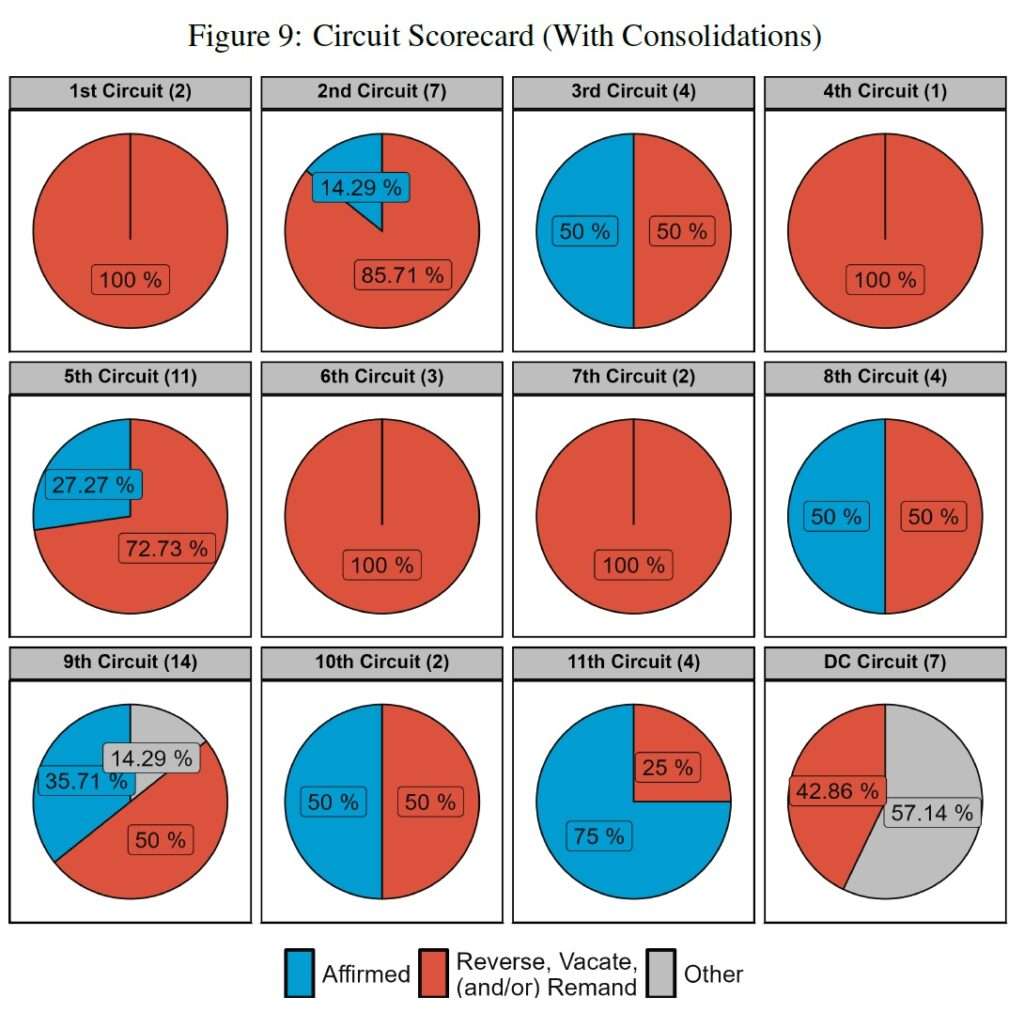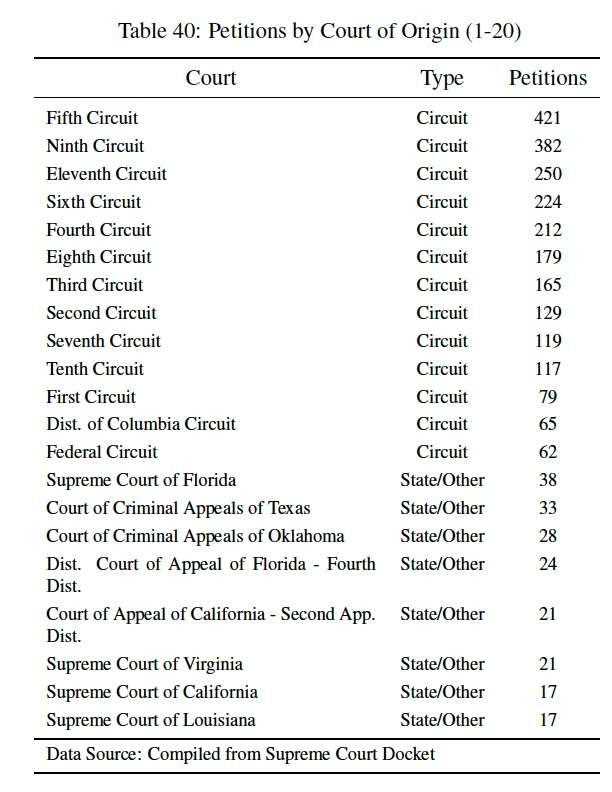The Volokh Conspiracy
Mostly law professors | Sometimes contrarian | Often libertarian | Always independent
Which Circuit Had The Highest Reversal Rate?
It was not the Fifth Circuit.
Last term, SCOTUSBlog ceased to publish its reliable StatPack. I am pleased that Adam Feldman and Jake Truscott have published a Stat Review of OT 2023. You should read through the rich 68-page report in detail. Here, I'd like to tease out one datapoint.
Which Circuit had the highest reversal rate? Surely it must be the Fifth Circuit, right? No. It was the Second Circuit. The Second Circuit's reversal rate was 85.71%. And for those keeping track at home, all but one were unanimous, 9-0 reversals: Murray v. UBS, Macquarie, Bissonette, Cantero, and NRA v. Vullo.
For the Fifth Circuit, if we include consolidated cases (such as AHM, and NetChoice), the reversal rate was 72.73%. The most prominent unanimous reversal was in AHM. Another unanimous reversal came in Devillier, though that holding was on completely different grounds than the Fifth Circuit ruled, and in some regards, was actually a victory for Texas. (No, I won't get into that mess again.) NetChoice was sort-of-unanimous, but it was a very strange reversal. For what it's worth, the Eleventh Circuit was also reversed (It seems the SEC East has a much higher affirmance rate than the SEC West.) The other reversals of the Fifth Circuit split 8-1 (Rahimi and Trevino), 7-2 (CFPB), and 6-3 (Murthy).
By my rough count, it seems the Second Circuit may have had a worse term this year than the Fifth Circuit. But that doesn't fit the narrative.

Another interesting data point. There were 421 cert petitions from the Fifth Circuit. (At least 420 of those were from the Solicitor General's Office--I'm kidding, I'm kidding). The Ninth Circuit, which is far larger, had only 382 cert petitions. And the Second Circuit, which had a higher reversal rate, yielded only 129 cert petitions.

I realize it is en vogue to dump on the Fifth Circuit, and fault lawyers in that circuit for shoddy advocacy. I was quoted today in one such piece about the reversal rate by the Texas Tribune, titled "Again and again, U.S. Supreme Court slaps down 5th Circuit." But I think that criticism misses the mark. I told the Trib:
Josh Blackman, a professor at South Texas College of Law, said these rulings reflect the simple fact that the 5th Circuit is to the right of the Supreme Court.
"Every judge takes an oath to the Constitution, and I think the judges in the 5th Circuit, and really all the courts, have very strong views on what the Constitution means," Blackman said. "The Supreme Court disagrees on that. That's their call."
…
This repeated repudiation from the Supreme Court is unlikely to impact how the 5th Circuit rules going forward.
"The judges of the 5th Circuit don't work for the Supreme Court anymore than I work for you," Blackman said. "It's a myth that the 5th Circuit will say, 'Oh man, I got reversed. Maybe I should rule differently next time.'"
The job of an appellate judge is not to try to guess what opinions would be upheld by the Supreme Court, Blackman said.
The bigger problem is when the Court shifts doctrine on the fly. It makes it much harder for lower-court judges to do their jobs. I think this is especially true in Rahimi (Second Amendment and facial challenges) and Murthy (standing), two of the higher-profile reversals.
Update: An IP Professor reminded me that in fact the Circuit Court with the highest reversal rate was the Federal Circuit--it went 0-2.
Editor's Note: We invite comments and request that they be civil and on-topic. We do not moderate or assume any responsibility for comments, which are owned by the readers who post them. Comments do not represent the views of Reason.com or Reason Foundation. We reserve the right to delete any comment for any reason at any time. Comments may only be edited within 5 minutes of posting. Report abuses.
Please to post comments


>The job of an appellate judge is not to try to guess what opinions would be upheld by the Supreme Court, Blackman said.
Isn't it their job to follow precedent?
And shouldn't the denominator in these analyses be the total number of cases, not the number of cases taken by SCOTUS?
Only SCOTUS can reverse a Circuit court. If SCOTUS doesn't take the case, then that's the end of the road. So why should the denominator be the total number taken?
The denominator should be the total number of cases that were appealed to the SC.
Affirmed and SC declining to hear it should both in the “good” numerator.
The only meaningful metric is the percent of total cases reversed by the supreme court.
A circuit that issues 100 rulings, has 1 taken by SCOTUS and has that case overturned yields a 100% reversal.
But a circuit that issues 100 rulings, has 10 taken by SCOTUS and 5 reversed, has only a 50% reversal.
But the first example has a much lower likelihood of any given ruling being reversed by SCOTUS than the second. 1% vs 5%.
Maybe. But as far as SCOTUS review, not all cases are equal. SCOTUS generally only takes cases with important issues of law, or where the lower courts are split. Most appellate decisions are routine and do not present questions which are important enough for SCOTUS. (The intermediate courts, OTOH, generally have to take anything put before them, as generally there is an appeal as of right.)
So the number of SCOTUS reversals or affirmances over the total number of decisions does not tell you how well that Circuit is doing, because it could be that that Circuit just had more important cases.
In one type of case, national injunctions, they're supposed to do this, in the form of the additional checkbox, likely to ultimately succeed, one of its requirements.
"You should read through the rich 68-page report in detail."
I had a professor like that. He melted down at a library desk -- trembling, shouting, perhaps in tears -- a few days before Christmas, when he was informed Law Week (or whatever it was called) was late in the mail and that he therefore wouldn't be able to read some new Supreme Court opinions until the library reopened after the holiday break.
I always felt sorry for that guy. No family. No real friends. Just his slip opinions.
And people who love model trains are freaks, too.
I have purchased a number of model trains.
Never owned one, though -- (except a red caboose I received as a gift and family memento, and kept on an office shelf for years).
I worked with a rainmaking partner who took me along on a number of work-related trips. In several towns he found shops that sold model trains and invited me along (he collected trains). At least half the time he had forgotten his wallet, or didn't have enough cash on him, so I got to pay.
That guy got me started on an enjoyable and lucrative career. He recently gave me a ticket to an event whose cost probably dwarfed the aggregate cost of those train cars. It's usually better to try not to worry about modest amounts of money among friends, especially when you're the junior associate.
Goshdarnit, if Blackman was just a tad more important, he could have as his friend the ultimate friend-of-the-court: Harlan
No, I don't think that's the thing that people criticize!
You left out the Federal Circuit from your pie charts.
You do realize that the numbers are too small to be statistically significant....
Indeed. The Fourth Circuit had one case go to SCOTUS and was reversed. The 100% reversal rate there means nothing about the Fourth Circuit in general.
Why do you suppose Prof. Blackman didn't include the thoughtful, nuanced criticism of Fifth Circuit litigants he had provided to the Texas Tribune?
'The job of an appellate judge is not to try to guess what opinions would be upheld by the Supreme Court, Blackman said. But the string of legal losses may still have an impact on how this legal strategy plays out going forward.
'“It’s not surprising that conservative litigants are getting more aggressive because you have a conservative Supreme Court,” said Blackman “But three years in, there have been a lot of cases that just did not yield success. Do they reevaluate and reassess? Or do they keep bringing these cases even when the Supreme Court keeps saying, ‘Go away. Go away. Go, we don't want these cases.’”'
That's slicing the bologna pretty thin. The Second Circuit had the highest reversal rate over the Fifth *by one case*. And the Fifth had the most reversals.
"Lies, damned lies & Statistics" - attributed to Twain.
In most of the US (across state & federal) affirmance of trial court decisions is about 80%. In England about 50%. Prof. Blackman would seem to believe English judges are not as good as US. I believe that since the English system requires permission to appeal if one considered the cases screened out by no permission they are comparable. As others have pointed out, since everything comes "by permission" (cert) to SCOTUS what percent they affirm and reverse doesn't say much. And as others point out, 2d Cir had one case reversed; 5th had 3. Which is better?
Quote: "Which Circuit had the highest reversal rate? Surely it must be the Fifth Circuit, right? No. It was the Second Circuit. The Second Circuit's reversal rate was 85.71%."
I am not a lawyer and I am using old math but Figure 9 clearly shows not 1, not 2 but 4 (four) Circuits with the much higher Reversal rate of 100%. And adding in the Federal Circuit that you admit also had 100% reversal that makes 5.